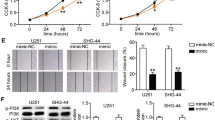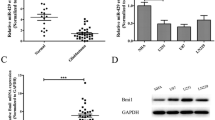Abstract
The purpose of this research was to examine the relationship between big mitogen-activated protein kinase 1 (BMK1) and miRNA miR-429 and to determine the effect of miR-429 on glioma invasiveness. Immunohistochemistry was used to evaluate BMK1 expression in glioma tissues. Real-time PCR was used to measure the expression of miR-429 and other RNAs. Western blot was used to detect the expression of BMK1 and other related proteins. Wound healing, Matrigel invasion, and chemotaxis assays were performed to detect the invasion and migration of glioma cell lines. The actual binding site of miR-429 to the 3′ untranslated region of BMK1 was confirmed by luciferase assay and RNA immunoprecipitation. BMK1 expression was associated with the World Health Organization grading of glioma and inversely correlated with patient survival. Suppression of BMK1 inhibited the migration and invasion of glioma cells by interfering with mesenchymal transition. Additionally, hepatocyte growth factor-induced GSK3β phosphorylation was suppressed through BMK1 knockdown. Interestingly, our findings validated a novel role for miR-429 in suppressing the migration and invasion of glioma by directly inhibiting BMK1 expression. We also found that miR-429 expression in glioma cells and tissues was lower than that in normal cells and adjacent non-neoplastic tissues, and miR-429 overexpression inhibited invasive activity of glioma cells both in vitro and in vivo. Furthermore, our data validated that miR-429 downregulation was due to the hypermethylation of its promoter region. Our results indicated that BMK1 modulation by miR-429 has an important function in glioma invasion both in vitro and in vivo.





Similar content being viewed by others
References
Rousseau A, Mokhtari K, Duyckaerts C (2008) The 2007 WHO classification of tumors of the central nervous system—what has changed? Curr Opin Neurol 21:720–727
Stupp R, Mason WP, van den Bent MJ, Weller M, Fisher B, Taphoorn MJ, Belanger K, Brandes AA, Marosi C, Bogdahn U, Curschmann J, Janzer RC, Ludwin SK, Gorlia T, Allgeier A, Lacombe D, Cairncross JG, Eisenhauer E, Mirimanoff RO, European Organisation for R, Treatment of Cancer Brain T, Radiotherapy G, National Cancer Institute of Canada Clinical Trials G (2005) Radiotherapy plus concomitant and adjuvant temozolomide for glioblastoma. New Engl J Med 352:987–996
Lu KV, Chang JP, Parachoniak CA, Pandika MM, Aghi MK, Meyronet D, Isachenko N, Fouse SD, Phillips JJ, Cheresh DA, Park M, Bergers G (2012) VEGF inhibits tumor cell invasion and mesenchymal transition through a MET/VEGFR2 complex. Cancer Cell 22:21–35
Velpula KK, Dasari VR, Tsung AJ, Dinh DH, Rao JS (2011) Cord blood stem cells revert glioma stem cell EMT by down regulating transcriptional activation of Sox2 and Twist1. Oncotarget 2:1028–1042
Shen SC, Wu MS, Lin HY, Yang LY, Chen YH, Chen YC (2014) Reactive oxygen species-dependent nitric oxide production in reciprocal interactions of glioma and microglial cells. J Cell Physiol 12:2015–2026
Dixit D, Ghildiyal R, Anto NP, Sen E (2014) Chaetocin-induced ROS-mediated apoptosis involves ATM-YAP1 axis and JNK-dependent inhibition of glucose metabolism. Cell Death Dis 5:e1212
Zhang Z, Lv J, Lei X, Li S, Zhang Y, Meng L, Xue R, Li Z (2014) Baicalein reduces the invasion of glioma cells via reducing the activity of p38 signaling pathway. PLoS One 9:e90318
Chen R, Yang Q, Lee JD (2012) BMK1 kinase suppresses epithelial-mesenchymal transition through the Akt/GSK3beta signaling pathway. Cancer Res 72:1579–1587
Zhou C, Nitschke AM, Xiong W, Zhang Q, Tang Y, Bloch M, Elliott S, Zhu Y, Bazzone L, Yu D, Weldon CB, Schiff R, McLachlan JA, Beckman BS, Wiese TE, Nephew KP, Shan B, Burow ME, Wang G (2008) Proteomic analysis of tumor necrosis factor-α resistant human breast cancer cells reveals a MEK5/Erk5-mediated epithelial-mesenchymal transition phenotype. Breast Cancer Res 10:R105
Calin GA, Dumitru CD, Shimizu M, Bichi R, Zupo S, Noch E, Aldler H, Rattan S, Keating M, Rai K, Rassenti L, Kipps T, Negrini M, Bullrich F, Croce CM (2002) Frequent deletions and down-regulation of micro- RNA genes miR15 and miR16 at 13q14 in chronic lymphocytic leukemia. Proc Natl Acad Sci USA 99:15524–15529
Zhang H, Shykind B, Sun T (2012) Approaches to manipulating microRNAs in neurogenesis. Front Neurosci 6:196
Ma L, Teruya-Feldstein J, Weinberg RA (2007) Tumour invasion and metastasis initiated by microRNA-10b in breast cancer. Nature 449:682–688
Tucci P, Agostini M, Grespi F, Markert EK, Terrinoni A, Vousden KH, Muller PA, Dotsch V, Kehrloesser S, Sayan BS, Giaccone G, Lowe SW, Takahashi N, Vandenabeele P, Knight RA, Levine AJ, Melino G (2012) Loss of p63 and its microRNA-205 target results in enhanced cell migration and metastasis in prostate cancer. Proc Natl Acad Sci USA 109:15312–15317
Sun Y, Shen S, Liu X, Tang H, Wang Z, Yu Z, Li X, Wu M (2014) miR-429 inhibits cells growth and invasion and regulates EMT-related marker genes by targeting Onecut2 in colorectal carcinoma. Mol Cell Biochem 390:19–30
Chen J, Wang L, Matyunina LV, Hill CG, McDonald JF (2011) Overexpression of miR-429 induces mesenchymal-to-epithelial transition (MET) in metastatic ovarian cancer cells. Gynecol Oncol 121:200–205
Liang QL, Mo ZY, Wang P, Li X, Liu ZX, Zhou ZM (2014) The clinical value of serum hepatocyte growth factor levels in patients undergoing primary radiotherapy for glioma: effect on progression-free survival. Med Oncol 31:122
Kalluri R, Weinberg RA (2009) The basics of epithelial-mesenchymal transition. J Clin Investig 119:1420–1428
Zhang B, Gu F, She C, Guo H, Li W, Niu R, Fu L, Zhang N, Ma Y (2009) Reduction of Akt2 inhibits migration and invasion of glioma cells. Int J Cancer 125:585–595
Huber MA, Kraut N, Beug H (2005) Molecular requirements for epithelial-mesenchymal transition during tumor progression. Curr Opin Cell Biol 17:548–558
Wang S-P, Wang W-L, Chang Y-L, Wu C-T, Chao Y-C, Kao S-H, Yuan A, Lin C-W, Yang S-C, Chan W-K, Li K-C, Hong T-M, Yang P-C (2009) p53 controls cancer cell invasion by inducing the MDM2-mediated degradation of Slug. Nat Cell Biol 11:694–704
Kim JY, Kim YM, Yang CH, Cho SK, Lee JW, Cho M (2012) Functional regulation of Slug / Snail2 is dependent on GSK-3β-mediated phosphorylation. FEBS J 279:2929–2939
Johnson A (2009) TNF-induced activation of pulmonary microvessel endothelial cells: a role for GSK3beta. Am J Physiol Lung Cell Mol Physiol 296:L700–L709
Ambros V (2008) The evolution of our thinking about microRNAs. Nat Med 14:1036–1040
Durante M, Pignalosa D, Jansen JA, Walboomers XF, Ritter S (2010) Influence of nuclear geometry on the formation of genetic rearrangements in human cells. Radiat Res 174:20–26
Kozaki K, Imoto I, Mogi S, Omura K, Inazawa J (2008) Exploration of tumor-suppressive microRNAs silenced by DNA hypermethylation in oral cancer. Cancer Res 68:2094–2105
Shukla A, Miller JM, Cason C, Sayan M, MacPherson MB, Beuschel SL, Hillegass J, Vacek PM, Pass HI, Mossman BT (2013) Extracellular signal-regulated kinase 5: a potential therapeutic target for malignant mesotheliomas. Clin Cancer Res 19:2071–2083
Gros J, Tabin CJ (2014) Vertebrate limb bud formation is initiated by localized epithelial-to-mesenchymal transition. Science 343:1253–1256
Herzog BH, Fu J, Wilson SJ, Hess PR, Sen A, McDaniel JM, Pan Y, Sheng M, Yago T, Silasi-Mansat R, McGee S, May F, Nieswandt B, Morris AJ, Lupu F, Coughlin SR, McEver RP, Chen H, Kahn ML, Xia L (2013) Podoplanin maintains high endothelial venule integrity by interacting with platelet CLEC-2. Nature 502:105–109
Siebzehnrubl FA, Silver DJ, Tugertimur B, Deleyrolle LP, Siebzehnrubl D, Sarkisian MR, Devers KG, Yachnis AT, Kupper MD, Neal D, Nabilsi NH, Kladde MP, Suslov O, Brabletz S, Brabletz T, Reynolds BA, Steindler DA (2013) The ZEB1 pathway links glioblastoma initiation, invasion and chemoresistance. EMBO Mol Med 5:1196–1212
Lujambio A, Lowe SW (2012) The microcosmos of cancer. Nature 482:347–355
Wang D, Qiu C, Zhang H, Wang J, Cui Q, Yin Y (2010) Human microRNA oncogenes and tumor suppressors show significantly different biological patterns: from functions to targets. PLoS One 5:e13067
Zhu W, He J, Chen D, Zhang B, Xu L, Ma H, Liu X, Zhang Y, Le H (2014) Expression of miR-29c, miR-93, and miR-429 as potential biomarkers for detection of early stage non-small lung cancer. PLoS One 9:e87780
Liu X, Liu Y, Wu S, Shi X, Li L, Zhao J, Xu H (2014) Tumor-suppressing effects of miR-429 on human osteosarcoma. Cell Biochem Biophys 70:215–224
Sun Y, Shen S, Tang H, Xiang J, Peng Y, Tang A, Li N, Zhou W, Wang Z, Zhang D, Xiang B, Ge J, Li G, Wu M, Li X (2014) miR-429 identified by dynamic transcriptome analysis is a new candidate biomarker for colorectal cancer prognosis. OMICS 18:54–64
Brugnera E, Haney L, Grimsley C, Lu M, Walk SF, Tosello-Trampont AC, Macara IG, Madhani H, Fink GR, Ravichandran KS (2002) Unconventional Rac-GEF activity is mediated through the Dock180-ELMO complex. Nat Cell Biol 4:574–582
Jarzynka MJ, Hu B, Hui KM, Bar-Joseph I, Gu W, Hirose T, Haney LB, Ravichandran KS, Nishikawa R, Cheng SY (2007) ELMO1 and Dock180, a bipartite Rac1 guanine nucleotide exchange factor, promote human glioma cell invasion. Cancer Res 67:7203–7211
Li J, Guan HY, Gong LY, Song LB, Zhang N, Wu J, Yuan J, Zheng YJ, Huang ZS, Li M (2008) Clinical significance of sphingosine kinase-1 expression in human astrocytomas progression and overall patient survival. Clin Cancer Res 14:6996–7003
Galluzzi L, De Santi M, Crinelli R, De Marco C, Zaffaroni N, Duranti A, Brandi G, Magnani M (2012) Induction of endoplasmic reticulum stress response by the indole-3-carbinol cyclic tetrameric derivative CTet in human breast cancer cell lines. PLoS One 7:e43249
Xie CG, Wei SM, Chen JM, Xu XF, Cai JT, Chen QY, Jia LT (2012) Down-regulation of GEP100 causes increase in E-cadherin levels and inhibits pancreatic cancer cell invasion. PLoS One 7:e37854
Rollo EE, Hempson SJ, Bansal A, Tsao E, Habib I, Rittling SR, Denhardt DT, Mackow ER, Shaw RD (2005) The cytokine osteopontin modulates the severity of rotavirus diarrhea. J Virol 79:3509–3516
Lu SY, Li M, Lin YL (2010) Mitf induction by RANKL is critical for osteoclastogenesis. Mol Biol Cell 21:1763–1771
Albini A, Iwamoto Y, Kleinman HK, Martin GR, Aaronson SA, Kozlowski JM, McEwan RN (1987) A rapid in vitro assay for quantitating the invasive potential of tumor cells. Cancer Res 47:3239–3245
Zhang B, Yin C, Li H, Shi L, Liu N, Sun Y, Lu S, Liu Y, Sun L, Li X, Chen W, Qi Y (2013) Nir1 promotes invasion of breast cancer cells by binding to chemokine (C-C motif) ligand 18 through the PI3K/Akt/GSK3beta/Snail signalling pathway. Eur J Cancer 49:3900–3913
Tan LP, Seinen E, Duns G, de Jong D, Sibon OC, Poppema S, Kroesen BJ, Kok K, van den Berg A (2009) A high throughput experimental approach to identify miRNA targets in human cells. Nucleic Acids Res 37:e137
Cheng GZ, Zhang W, Wang LH (2008) Regulation of cancer cell survival, migration, and invasion by Twist: aKT2 comes to interplay. Cancer Res 68:957–960
Shi L, Zhang B, Sun X, Lu S, Liu Z, Liu Y, Li H, Wang L, Wang X, Zhao C (2014) MiR-204 inhibits human NSCLC metastasis through suppression of NUAK1. Br J Cancer 111:2316–2327
Acknowledgments
This work was supported by National Natural Scientific Foundation of China (81072068,81472365), Scientific Foundation of Shandong Province(ZR2014HM003, 2014ZRB14097),The Young and Middle-Aged Scientists Research Awards Fundation of Shandong Province (2010BSB14050), Foundation of Shandong Educational Committee (J14LK13).
Author contributions
Conception and design: Baogang Zhang; Financial support and designed research: Baogang Zhang and Weiyi Chen; Performed research and analyzed data: Weiyi Chen, Baogang Zhang, Wenjun Guo, Linlin Gao, Lihong Shi, Hongli Li, Shijun Lu, Yuqing Liu and Xiaolong Li. All authors have read and approved the final manuscript.
Author information
Authors and Affiliations
Corresponding author
Additional information
Weiyi Chen and Baogang Zhang have contributed equally to this work.
Electronic supplementary material
Below is the link to the electronic supplementary material.
Rights and permissions
About this article
Cite this article
Chen, W., Zhang, B., Guo, W. et al. miR-429 inhibits glioma invasion through BMK1 suppression. J Neurooncol 125, 43–54 (2015). https://doi.org/10.1007/s11060-015-1887-x
Received:
Accepted:
Published:
Issue Date:
DOI: https://doi.org/10.1007/s11060-015-1887-x




